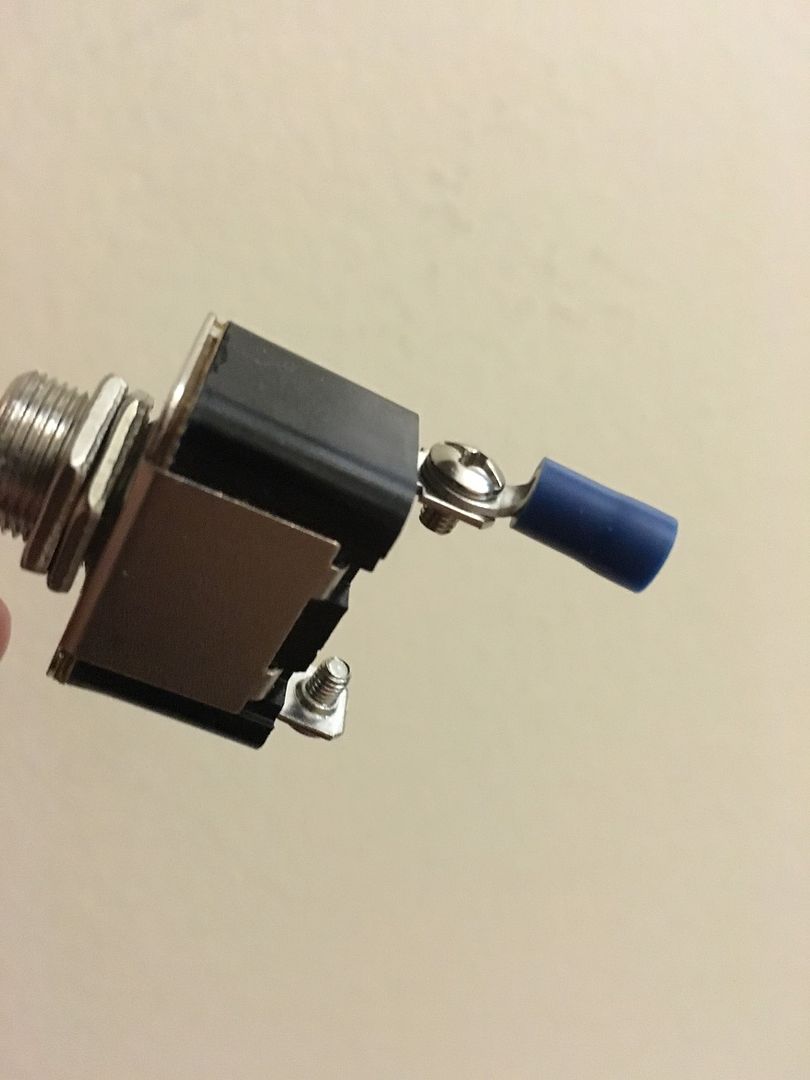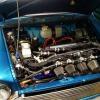Do you?


Posted 18 May 2016 - 07:59 PM
For small connections like that and especially electrical I use star washers, they dig into the surfaces helping create a decent connection and then don't come back undone on their own.
Posted 18 May 2016 - 08:00 PM
Generally no Loctite on electrical connections.
What you can do, after assembly, is to put a dab of RTV on the edge of the screw head. The RTV serves to keep the screw from rotating but isn't in the electrical joint.
Posted 18 May 2016 - 08:55 PM
Star washer or a spring washer for me.
Posted 18 May 2016 - 11:08 PM
Posted 19 May 2016 - 08:27 AM
Personally I wouldn't use a threaded connections at all for the reason you've mentioned - moved of the wire can act like a spanner. My personal preference is to build tails soldered onto the device (in this case a switch) and then crimped into a standard form connector (something like an econoseal or mate-n-lock depending on location).
Edited by Icey, 19 May 2016 - 08:28 AM.
Posted 19 May 2016 - 09:45 AM
Thanks for the thoughts.
Interesting that thread lock does not seem to be a goer. And I can see why. Bug I was thinking of a paste version like 238 ,I think.
Might just go for a nylock on the screw as there is space. If I went for the star washer I would be concerned that any movement in the wire could impart motion on the screw. Star washer between screw head and connector, so I would think about a second between connector and terminal.
Yes the cables will be anchored close by but..... Racecar.
Posted 19 May 2016 - 11:25 AM
Thanks for the thoughts.
Interesting that thread lock does not seem to be a goer. And I can see why. Bug I was thinking of a paste version like 238 ,I think.
Might just go for a nylock on the screw as there is space. If I went for the star washer I would be concerned that any movement in the wire could impart motion on the screw. Star washer between screw head and connector, so I would think about a second between connector and terminal.
Yes the cables will be anchored close by but..... Racecar.
Standard for us on aircraft to have electrical terminals connected by screw with either a star washer or spring washer. A sight more vibration than a race car.
agreed but are they M3? I just don't see any benefit of locking the terminal to the retainer when it can undo it. Ok if you have loads of wires together so they cant move it becomes much less of an issue.
lock nuts I think it will be.
Posted 19 May 2016 - 08:18 PM
Nick, as the other have said, a (Internal) Star Washer will be fine. If you want belt and braces, then also fit a plain nut to lock it with, but I wouldn't fit a nyloc, especially on something so small as there's no 'feel' to how tight they really are.
Also, don't be temped to over-tighten as over time the copper of the crimp connector will flow and a hot connection will result.
Also also, I'd suggest finding non insulated crimps, then after crimping, solder, then heat shrink. Many of the better quality non insulated crimps are made from tube, where as all the insulated types are just folded / rolled sheet and can open up.
Posted 19 May 2016 - 10:43 PM
Posted 20 May 2016 - 12:27 AM
solder and heat shrink, next time you touch it will be because the switch failed
Posted 20 May 2016 - 08:47 AM
I understand the argument for not using thread lock fluid and using a star washer, but would it realistically effect the electrical connection?? Surely the flat surface of the ring and the flat surface of the spade would be enough of a contact so as to not worry about the tread of the screw potentially being insulated by the thread lock?
I'm not disagreeing with what folks have suggested with star washers (that is what I would do), but looking at this from a purely mechanical view, the 2 flat surfaces wouldn't be effected by thread lock unless you lobbed a load of it all over the surfaces and thread and completely balls up the job.......right?
Posted 20 May 2016 - 09:07 AM
Posted 20 May 2016 - 11:55 AM
I understand the argument for not using thread lock fluid and using a star washer, but would it realistically effect the electrical connection?? Surely the flat surface of the ring and the flat surface of the spade would be enough of a contact so as to not worry about the tread of the screw potentially being insulated by the thread lock?
I'm not disagreeing with what folks have suggested with star washers (that is what I would do), but looking at this from a purely mechanical view, the 2 flat surfaces wouldn't be effected by thread lock unless you lobbed a load of it all over the surfaces and thread and completely balls up the job.......right?
At work we avoid Loctite on any and all threaded electrical connections. As mentioned by those above, we typically use zinc plated fasteners, bare (unanodized) tapped holes, and star washers. On the couple of budget race cars I have worked on the threaded connections have been secured by a dab of RTV on the fastener AFTER assembly.
If you were only worried about a low level signal passing through the switch you might be OK. However, toggle switches like the OP shows in his picture are often carrying a few Amps and that's where you don't want any non-conductive material in the connection.
Posted 20 May 2016 - 03:39 PM
I understand the argument for not using thread lock fluid and using a star washer, but would it realistically effect the electrical connection?? Surely the flat surface of the ring and the flat surface of the spade would be enough of a contact so as to not worry about the tread of the screw potentially being insulated by the thread lock?
I'm not disagreeing with what folks have suggested with star washers (that is what I would do), but looking at this from a purely mechanical view, the 2 flat surfaces wouldn't be effected by thread lock unless you lobbed a load of it all over the surfaces and thread and completely balls up the job.......right?
At work we avoid Loctite on any and all threaded electrical connections. As mentioned by those above, we typically use zinc plated fasteners, bare (unanodized) tapped holes, and star washers. On the couple of budget race cars I have worked on the threaded connections have been secured by a dab of RTV on the fastener AFTER assembly.
If you were only worried about a low level signal passing through the switch you might be OK. However, toggle switches like the OP shows in his picture are often carrying a few Amps and that's where you don't want any non-conductive material in the connection.
Ok, how about one all assembled, the OP could put a lock nut on the rear of this connection but loctite that on? This would have zero effect on the conductivity of the of the connection would it not?
I still doubt that loctite in this situation would actually make the blindest bit of difference to the function unless as I previously stated it gets pasted all over the joint.
Mini Technical Sections →
Problems, Questions and Technical →
Misfire - Ignition Fault Or Fuel Problem?Started by derekaka2sheds , 01 Apr 2024 |
|

|
||
Mini Technical Sections →
Problems, Questions and Technical →
Mini Spi Charging IssueStarted by Dutch_MiniSPI , 27 Mar 2024 |
|
|
||
Mini Technical Sections →
Problems, Questions and Technical →
Main Dipped Beam Not Working - Just Before Mot :-(Started by Park , 24 Mar 2024 |
|

|
||
Mini Technical Sections →
Problems, Questions and Technical →
Speeduino EcuStarted by cooperpooper , 09 Mar 2024 |
|

|
||
Mini Technical Sections →
Problems, Questions and Technical →
Smiths Electronic Speedo Accuracy?Started by chuee , 01 Mar 2024 |
|

|
0 members, 1 guests, 0 anonymous users